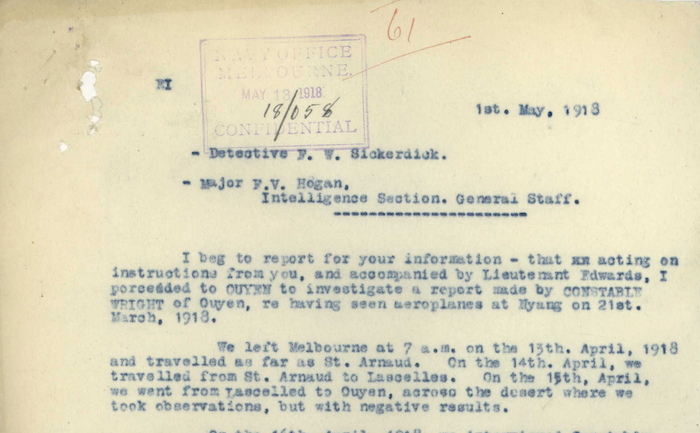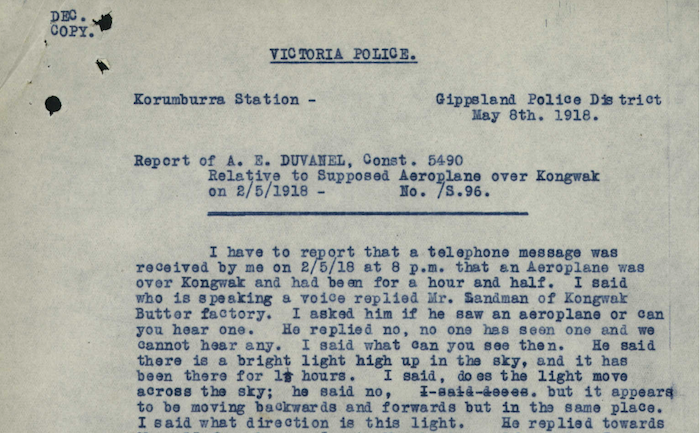
NAA: MP1049/1, 1918/066, pages 849 through 854 is a report from Detective F. W. Sickerdick of Victoria Police (seconded to military intelligence for the duration, possibly due to German descent) to Major F. V. Hogan of the Intelligence Section, General Staff. Sickerdick had been ordered by Hogan to travel with Lieutenant A. Edwards of the Royal Flying Corps (though it should be Royal Air Force by now. Thanks to his common name, I’ve not been able to trace him; perhaps an airman invalided home?) to investigate the mystery aeroplane sighting that started this whole panic, the one by Constable Wright at Nyang back on 21 March. Sickerdick and Edwards left Melbourne on 13 April and spent two weeks scouring the Mallee for corroborating evidence, talking not only to Wright himself but seemingly every potential witness they could find in Ouyen, Walpeup, Nyang, Underbool, Pink Lakes, Yellingip, Paigney, Tiega, Sea Lake, Ararat… in other words, they were very thorough. They did find some other people who had seen strange things in the air:
- Mrs Tilley at Ouyen: ‘it had one pair of wings and a very long tail’
- four ‘boys’ (some were young men) playing tennis at Ouyen: ‘I could see 2 wings, and something like a tail’
- a 16 year girl at Walpeup: it ‘had a red light flying at the back, and appeared to have two white side lights’
- Mrs McDonald at Ararat: ‘an object circling’
Several people also heard odd noises, but did not see anything.
Sickerdick and Edwards also interviewed Schefferdecker, the naturalised German farmer who had been accused by an anonymous letter-writer of having some connection with the mystery aeroplanes at Nyang. They looked closely into him and his wife, an Austrian, and seem satisfied that he is nothing to worry about. Before returning to Melbourne to file this report, Sickerdick and Edwards were ordered to Warrnambool to investigate aeroplane sightings made near the coast (making these reports separately; see NAA: MP1049/1, 1918/066, pages 142 through 145. Edwards was sent out again to interview Sutton, the drover: see NAA: MP1049/1, 1918/066, pages 146 through 148).
In my article I cite Sickerdick’s report three times, but most importantly for his conclusion:
In my opinion and from the observations taken abd [sic] from information received, the opinion of the residents, and the country travelled through, I do not believe that aeroplanes ever flew over the MALLEE, and I believe the objects seen at different times and by different people, were either hawks or pelicans.
Indeed, Sickerdick and Edwards themselves ‘saw a number of large eagles hovering in the sky which resembled aeroplanes’, at Walpeup, Nyang, Cowangie and Murrayville.
Although I didn’t comment on it in my article, one of the interesting things about this report is the evidence it provides for the working of rumour, hearsay and consensus. They spent a lot of time tracking down people who somebody else had told them had seen something, only to find that the truth was rather different. For example, Mrs McDonald told the investigators that Mrs Hargreaves had seen the same aeroplane she had; but Mrs Hargreaves herself said ‘the only plane she has ever seen was when Mr. Carey from Ballarat gave an exhibition in that town some considerable time ago’. Even more suggestive are the independent interviews with three of the four ‘boys’ playing tennis at Ouyen, which allows us to reconstruct how they interpreted what they saw, and more importantly, how they talked to each other about it:
- Harry Leech, 18: ‘Allen Crighton said said “look at the hawk”, I said “it is not a hawk, it is an aeroplane” — at the time I said it I didn’t think it was an aeroplane […] since Constable Wright has reported that an aeroplane were [sic] seen, I believed the object I saw was also an aeroplane’
- Allen Crighton, 11: ‘I saw what I thought was an eagle flying directly over us towards Mildura, Harris said “it is an aeroplane, if you look at the ‘Argus’ next Wednesday you will see where an aeroplane was flown from Melbourne to Mildura[“]. I now believe that it was an aeroplane I saw’
- Lionel Pelling, bank clerk: ‘one of the boys said “look at the bird in the air, and I believe I suggested that it was an aeroplane […] I have seen aeroplanes before when I have been in Melbourne’
So it seems that one of the boys (Crighton) pointed out what he thought was a hawk, and then the rest of them all chorused no, it’s actually an aeroplane, as least one (Leech) jokingly. By this point in time, all three believed that they’d seen an aeroplane, in part due to corroboration by authority (Constable Wright), possibly also through retelling their story (which no doubt made them minor celebrities) and through media reinforcement. It’s interesting that one boy (Harris, who was no longer in the area and so couldn’t be interviewed) shows an awareness of an aeroplane flight still being newsworthy at this time; even if there was no thought that it was a hostile aircraft, they knew an aeroplane was something much bigger in the outside world, and much more interesting, than a mere hawk.
![]() This work is licensed under a Creative Commons Attribution-NonCommercial-NoDerivatives 4.0 International License.
Permissions beyond the scope of this license may be available at http://airminded.org/copyright/.
This work is licensed under a Creative Commons Attribution-NonCommercial-NoDerivatives 4.0 International License.
Permissions beyond the scope of this license may be available at http://airminded.org/copyright/.






Pingback: Friday, 10 May 1918 – Airminded
Pingback: Friday, 31 May 1918 – Airminded
Pingback: Monday, 3 June 1918 – Airminded